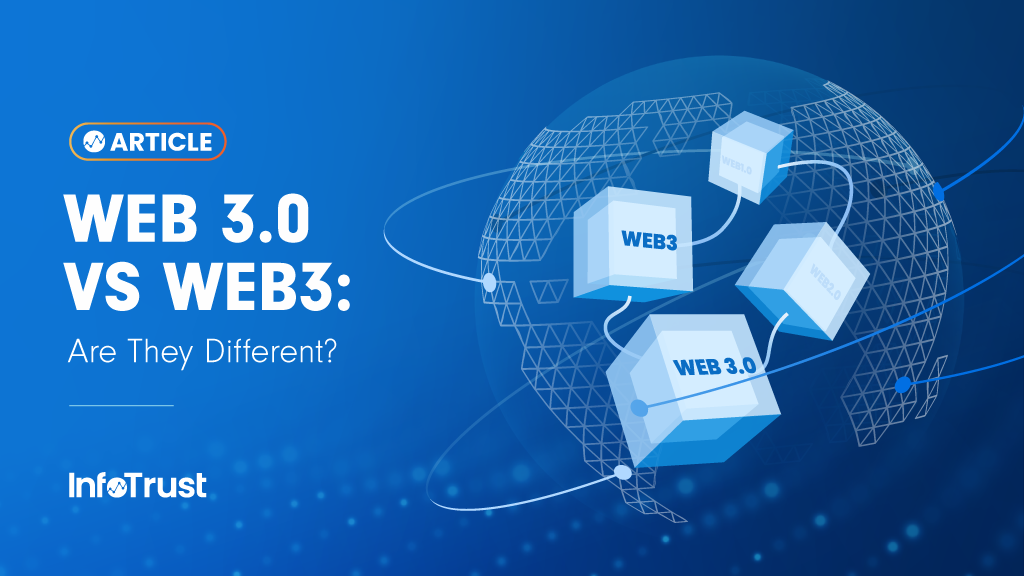What is this “web3” everyone is talking about? If you have found yourself asking this question, you probably didn’t get a really clear definition. In fact, as you travel the internet, people will confidently tell you what they think web3 or Web3.0 is, but that definition will change from blog to blog, site to site. My thoughts on what web3 is can be summed up by a quote from Molly White’s Is web3 Bullshit?:
“The thing about a term like ‘web3’ is you don’t necessarily know what it is until it’s happened. You don’t know what that fundamental shift is going to be that brings about a sea change in the web that deserves the name ‘web3’.”
Some people will read that and be outraged that someone is claiming there has not been a sea change yet. However, I am on Molly’s side with this one.
My role at InfoTrust is to navigate future technology trends such as server-side tag management, Customer Relationship Managers evolving into Customer Data Platforms in preparation for post-third party cookie deprecation, and of course under this logic, web3. I almost always approach these trends the same way:
- Is the new technology worth investigating?
- How quickly can I educate my team on the values of the new technology?
- How do I develop an internal lexicon to make sure we discuss this technology properly?
- Can we vet ideas for this technology against actual market use cases?
- How quickly can we go to market with a solution?
My goal here is not to bore you with a tedious vetting process, but instead to highlight where this may be more difficult when considering web3 and how it affects your field. Steps 2 and 3 specifically have been difficult because of how web3 has been loosely defined.
Let’s take a look at the list of things web3 could be:
- Blockchain: A cryptographically-linked list that operates as an immutable ledger
- Trustless Internet: A new internet concept using technology like blockchain to create environments where the concept of trust is not needed (it’s impossible to dupe the system)
- Decentralized Ownership: An internet where big tech no longer owns the system, but instead the users own the very internet itself, as well as underlying applications
- Digital Experiences: Augmented Reality (real life with a digital overlay) and Virtual Reality (a simulation of real life through a lens) expand the ways we interface with the physical world
- Monetary Incentive: An internet where taking part in the infrastructure pays you for taking part in the infrastructure. Rather than a few companies being the “hosting” infrastructure for sites and apps you visit, instead individual users of the internet lend part of their computers’ memory and processing to be part of hosting all the sites on the internet. This puts power in the users’ hands (paying them to do so), and keeps the internet from being a monopoly.
- Artificial Intelligence: By using logical engines, we improve the tedious tasks of the internet where machines can begin to make better decisions for us leading to a more productive internet.
- Personalization: A web where the internet knows exactly what you want and what to suggest for you to eat, listen to, what movie to see, etc. This is polarizing as many view this as paradise, and others view it as massively invasive.
- Digital Asset Ownership (including NFTs): An internet where the capitalist notions of physical ownership are transferred to the digital space. Art, property, music, games, etc. are owned, verified, and traded for their uniqueness.
- Semantic Web: A web of interconnected knowledge graphs that serves as a new backend for our internet. These connected data structures would serve to link information together in a more intelligent way to increase the ability of humans and machines to search data.
This is not a fully comprehensive list, but let’s stop here for now. As you travel the internet people will tell you, “web3 is blockchain”, “web3 is all about ownership”, or “web3 is really the Metaverse and digital experiences.” However, if we consider Molly White’s quote from earlier, while all of these things are cool new technology advances, this is not a sea change in the internet itself. This of course is my opinion, but defining terminology as a community helps us progress much faster. This lack of focus in the web3 definitions leads to confusion and disrupts progress.
Let’s look at one more thing, then we can wrap things up.
Why is it “web3?”
When Tim Berners-Lee made the first World Wide Web it wasn’t called Web 1.0, it was just the web. The features of this original web were very very limited. It essentially was a read-only source of information. Every website was a billboard for a company—look but don’t touch.
Then the community decided to evolve this web so the users could interact with it. What if I didn’t just see the pizza menu, but could order the pizza online? What if I didn’t just see pictures and articles, but I could upload my own pictures and write my own blogs? This step to interaction from the read-only internet was later coined Web 2.0, and by default the prior was labeled Web 1.0.
This is where the name web3 came from.
Tim Berners-Lee’s next vision for the internet was the Semantic Web, which he was calling Web 3.0 well before blockchain became popular. This was a focused and less chaotic vision for the next web and was making steady, slow progress at transforming how the web stores data.
Then blockchain came along and disrupted the internet and people tried to commandeer the title of Web 3.0, claiming this is the new web. However, as we have discussed at this point, the movement itself was decentralized and therefore without clear leadership. Some people respected TBL’s vision of Web 3.0 and claimed this was web3, not Web 3.0. Others said this is the true Web 3.0 and claimed this is the one true vision of the next iteration of the web. General confusion ensued and many began using the terms interchangeably.
So for the sake of tying things up, let me share with you my definitions for each of these industry terms:
Web 3.0 – In line with W3C’s and TBL’s vision for the next phase of the internet, Web 3.0 aims to build on top of Web 2.0 by organizing its data into semantic data models that will serve as a more human and machine-readable backbone for the internet. Web 3.0 is the Semantic Web.
Digital Experiences – AR/VR are both digital experiences, and while it would be easy for me to define these as part of the Metaverse, one company does not own all digital experiences and I do not want to pick terminology that suggests as much. Digital experiences are any digital formats that help us either interface or simulate the real world. Virtual malls, an art gallery projected in your own house, and holograms meeting in a virtual office space are all digital experiences. These are very cool, but not necessarily the third version of the web.
AI/ML – It’s no secret that machine learning and artificial intelligence have dominated the news cycle recently. The success of ChatGPT, a deep learning-based language model built on top of the OpenAI team’s open GPT model, has improved the speed at which we can access information which will undoubtedly have an impact across the web. However, I don’t classify AI/ML as a sea change on the internet, but instead tools that help pave the way to that sea change. The growth of AI/ML will affect Web 3.0, digital experiences, and web3. It is not a unique vision of the new internet, but instead serves as a way to speed up development and knowledge on our way to evolving the internet.
Also, as a footnote: AL/ML is much more than any GPT or large language model. Do not let hype cycles limit your scope of what you consider inside a working field. Definitely take advantage of improvements in technology, but always consider what else the field has to offer and its current applications to the market’s problem sets. With third-party cookies going away, we are in much greater need of concepts like synthetic data, forecasting, and cohort models for filling in data gaps than we are in need of a language model.
web3 – Web3 is better defined by the tenets it holds than the technology it has been written with. The pillars of web3 are decentralization, monetization through infrastructure ownership, and trustlessness. I expect web3 to be a correction of singular market control of big tech by decentralizing the infrastructure of the internet, where the web itself is served amongst all its users’ computers. The users who take part in this infrastructure are rewarded with some form of currency, usually called coins or tokens, that represent their stake in the infrastructure and the currency will be valued against the value brought by the system itself. Lastly, it’s not enough to build an owned, decentralized system. That system should also be completely trusted by the users. By being trustless from the start, web3 can create a safer environment for users on the internet. Web3 is not the guaranteed next version of the web, but instead an idealistic vision of where the web can be if we rebuild it on the pillars of ownership, decentralization, and trustlessness.
While blockchain and programs written on blockchain such as Bitcoin and Ethereum, as well as techniques for recording ownership of assets such as NFTs can all be considered web3, none of them individually make up web3. Web3 is a set of ideals in which the visionaries of the changing internet hold to be the pillars of new development. I would never want to limit the scope of what web3 could achieve by saying it’s just blockchain, but instead, think about how these pillars can erect a better infrastructure for tomorrow’s internet.
If you share my vision and you’re a tech, marketing, or measurement leader at an enterprise organization, I’d love to hear from you! InfoTrust is currently piloting initiatives across each of these three classifications, and we’d love to discuss the unique use cases and needs of your organization in this new reality.


